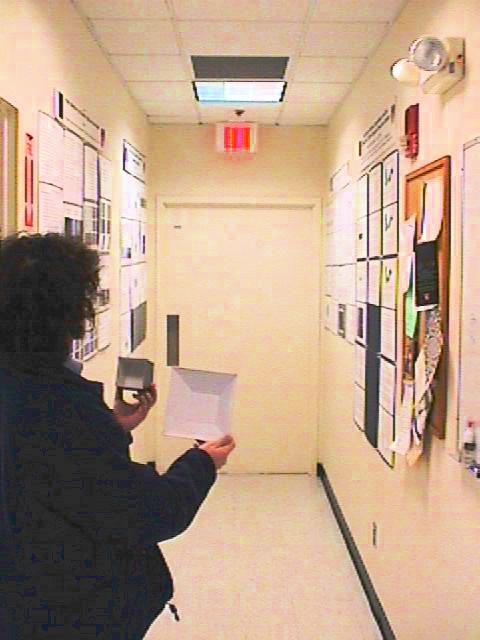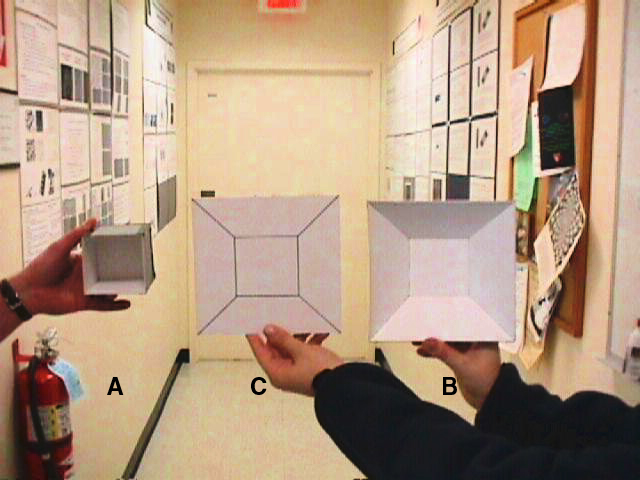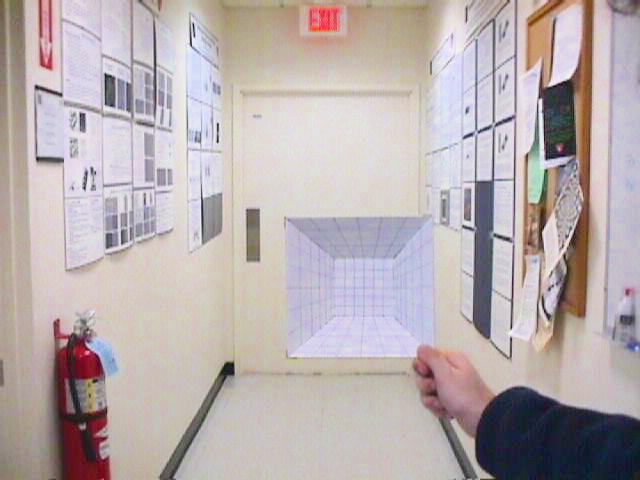
Here is a little experiment to demonstrate the properties of phenomenal perspective.
A hallway, or corridor, with a dead-end or end wall, as shown below.

The subject is placed at one end, looking down the hallway. The subject is then given three cardboard models, as depicted below, which he is allowed to examine and manipulate.

A rectangular box of approximately the same aspect ratio as the corridor, viewed from one end, which is open, as shown on the left, above. (Actual model was 3" square in cross section, length 4")
A truncated pyramid, viewed through the open base, i.e. composed of four identical trapezoids stretching from the nearer base towards the farther apex, meeting a square parallel to the base representing the far wall of the corridor, as shown to the right, above. In other words this is like an "Ames room" rendition of the corridor. (Actual model had 3" central square, and each trapezoid had 7" base, 3" side to meet central square, and 3" "height" i.e. perpendicular distance between the parallel sides)
A flat square of cardboard on which is drawn a perspective sketch of the corridor, similar to a photograph taken of that corridor from the subject's viewpoint, as shown in the middle model above. (Actual model was square of flat cardboard of 7" side, on which was drawn with black fine point marker a central square of 3" side, and four diagonal lines drawn from the corners of the central square to the nearest corner of the cardboard square)
"I will ask you questions about what you see when looking down this hallway. But what I am asking about is not what you know objectively about the geometry of the hallway, I am asking you what you see as a vivid spatial experience before you."
Which of these three models is closest to your spatial experience when looking down the hallway?
Results: "Model B" (70%)
Does the far end of the hallway look smaller than the near end?
Results: "Yes" (90%)
Do the sides of the hallway appear to converge?
Results: "Yes" (100%)
Is the far end of the hallway actually smaller than the near end?
Results: "No" (100%)
Do the sides of the hallway really converge?
Results: "No" (100%)
Is your experience of this hallway of a solid volumetric structure, or is it a flat two-dimensional experience?
Results: "Solid volumetric structure" (90%)
Is the convergence you observe a convergence of the solid volumetric experience of the hallway, or only of its two-dimensional projection?
Results: "Of the solid volumetric experience" (60%)
Can you imagine a cardboard model which captures what you see when you look down this hallway?
Results: various responses
Next, the subject is presented with a fourth model, as described and depicted below.

A truncated pyramid, identical to Model C, but with grid lines overlaid on all of its surfaces, that correspond to the convergence in the model, i.e. the longitudinal lines running parallel to the direction of the represented hallway converge by perspective to match the converging sides of the trapezoidal walls, floor, and ceiling, while the vertical and horizontal lines running at right angles to the direction of the represented hallway have a nonlinear spacing pattern, i.e. the spacing gets closer with distance down the represented hallway. In other words, this is like an "Ames room" rendition of a corridor whose walls, floor, and ceiling are tiled with a grid of square tiles. (Actual model had a 6 x 6 square grid on the end wall, as well as on the walls, floor, and ceiling of the model)
"Now look at this model, which is identical to one you saw earlier (Model B) except this time with grid lines. This grid represents the size scale of the model. In other words this is a scale model, like any scale model, except in this case the scale of the model varies with distance from the front, i.e. with a larger scale at the near end, and a smaller scale at the far end."
Does this model capture your spatial experience when looking down this hallway?
Results" "Yes" (90%)
This experiment indicates that visual perception is a fully three-dimensional experience. i.e. that the percept itself is a three-dimensional structure. There is a curious duality in size perception, where more distant objects appear to be smaller than nearer objects, and yet at the same time they are also "known" to be undiminished in size. This is why the visual experience of the hallway is reported to be similar both to models A and B, although neither A or B by itself seems to capture the duality in size perception. Model D on the other hand does incorporate the duality inherent in size perception, because objects in the distance are indeed smaller in that model, but since the size scale also shrinks with distance in the model, those objects are also registered as undiminished in size. In other words the shrinking size scale of model D itself incorporates the same kind of duality as that observed in phenomenal perspective. This experiment therefore suggests that the world of perceptual experience is expressed in a representation with a variable size scale, whose spatial scale diminishes with distance from the observer.